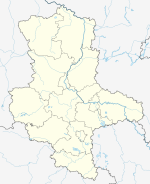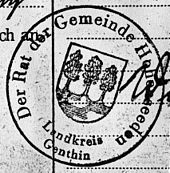High seas
|
High seas
Elbe-Parey municipality
|
|
|---|---|
| Coordinates: 52 ° 18 ′ 47 ″ N , 12 ° 0 ′ 48 ″ E | |
| Height : | 52 m above sea level NHN |
| Area : | 16 km² |
| Residents : | 402 (Dec. 2018) |
| Population density : | 25 inhabitants / km² |
| Incorporation : | September 1, 2001 |
| Postal code : | 39307 |
| Area code : | 039344 |
Location in Saxony-Anhalt
|
Hohenseeden is part of the Elbe-Parey community in the Jerichower Land district in Saxony-Anhalt .
geography
Hohenseeden is conveniently located on federal road 1 between the cities of Burg and Genthin and on state road 54 , on which the neighboring towns of Güsen and Gladau can be reached. The southeast of the district lies on a foothill of the Fläming , to the northwest the glacial valley of the Elbe extends . The location, embedded in forests and agricultural land, covers an area of around 40 hectares. The surrounding area drops from east to west from 60 to 38 m above sea level.
history
Hohenseeden was first mentioned in a document dated September 28, 992, in which Pope Lucius II confirmed to the Magdeburg Berge monastery, among other things, the ownership rights for the place "Sadun". Emperor Otto III. had given the village to the Berge monastery on August 18, 995. At that time the place was still a Slavic settlement. In a further document from 1145 the place name is referred to as “Sodun”, but in 1307 “Magnum Seeden” is mentioned for the first time. The addition Magnum = large indicates that at this point in time German settlement can be assumed. The original building of the Hohenseedener Church was erected around 1200. In another confirmation bull of Pope Innocent III. from 1209 it can be seen that the Vorwerk Schattberge (then called "Scatberch") also belonged to the village .
After Hohenseeden came into the possession of the von Treskow family, who lived in Niegripp , in the 15th century , Lippolt von Arnim acquired the place in 1509. In 1562 the Reformation was introduced in Hohenseeden . This year 28 landlords were counted, all of whom made a living from agriculture. In 1617 a new rectory was built. During the Thirty Years' War the town and church were looted and the village church burned down. After the end of the war in 1648 there was no longer any school building in the village, and there were no classes. Many of the surrounding fields were desolate .
In 1818, in the course of the Prussian administrative reform , Hohenseeden was assigned to the Jerichow II district with the district town of Genthin. The patronage over the place shared at this time four nobles, Count von der Schulenburg-Hessler, former Councilor Armin on Brandenstein and the former captain of Armin on Köckte and Pieschel. In the school chronicle, which has existed since 1825, it is reported that this year a linen weaver was allowed to teach the children up to the age of 8. On June 28, 1835, there was a major fire in the Hohenseeden, which killed 22 farms. However, the reconstruction of the houses was carried out so quickly that the farmers were still able to harvest the grain without major losses. In 1842 the village suffered from a severe drought in summer and unusually cold in autumn. There was a great famine in winter.
In 1894 there were 433 inhabitants in Hohenseeden, the school had 88 students. In the First World War , 14 soldiers from the Hohenseeden war lost their lives, in the Second World War 77 died. After the Second World War, many refugees from the eastern regions lived in the Hohenseeden. Catholic masses were again read for them in the village church . With the GDR territorial reform, Hohenseeden came into the Genthin district . The population was 508 in 1964.
In 1993 Hohenseeden received a bronze medal in the 17th national competition “ Our village should be more beautiful ”. On September 1, 2001, the municipality of Hohenseeden merged with other places from the Elbe-Parey administrative community to form the Elbe-Parey community.
politics
Hohenseeden has its own local council with five members.
The local mayor is Enrico Naue (Hohenseeden voter community).
coat of arms
|
Blazon : "In silver in a three-pass three seven-membered, black-structured green chestnut leaves with stems turned against each other, covered in the middle with a bursting fruit capsule."
The coat of arms was designed in 2000 by the municipal heraldist Jörg Mantzsch on the basis of drafts from the community and entered into the approval process. |
|
Historical coat of arms
The former community of Hohenseeden already had a coat of arms-like seal image in its community seal. This was used in the period after the Second World War until around the introduction of the districts and counties in the GDR (1945–1952). Another source is the County Home Museum in Genthin.
Culture and sights
Buildings
- The village church Hohenseeden was probably built around 1200 as a Romanesque stone church.
- In the Klausgartenberg , about 2.4 km to the north of the village, on the eastern part of an elongated sand dune in the lower part of the Parchener Bach (between the Lehmkuhlengraben (Königsgraben) and the Red Bridge Ditch) are the remains of old Slavic ramparts.
Regular events
- Easter fire
- Asparagus festival in May / June with fireworks
- Horse, small animal and farmer's market every second Saturday of the month (on the farmer's market - area directly on the B1)
- Equestrian festival (for 3 days always in summer)
societies
In addition to the volunteer fire brigade , the carnival association, the senior citizens association “Lindenblüte” and the mixed choir are particularly active in Hohenseeden.
Economy and Infrastructure
The place, which is quite quiet despite the main road, is mainly characterized by agriculture . Vegetable cultivation is of particular importance here. The most important product is asparagus , which is now grown on 150 hectares .
There is a farmers' market on the main road where regional products are sold. Once a month there is also a horse and small animal market.
In addition to a few handicraft businesses, there is also a restaurant in the village, so tourism is also an economic factor in the village.









